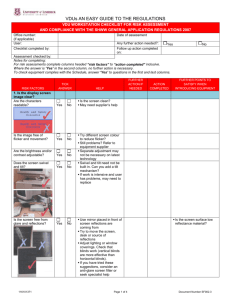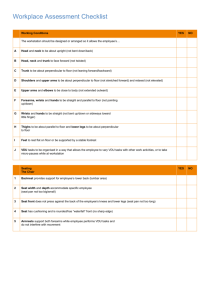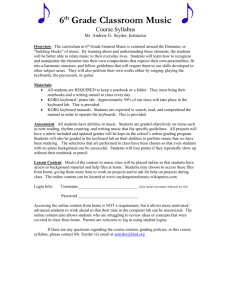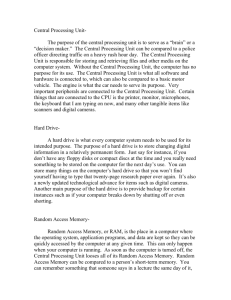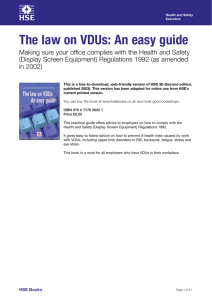Working at Home - London School of Hygiene & Tropical Medicine
advertisement
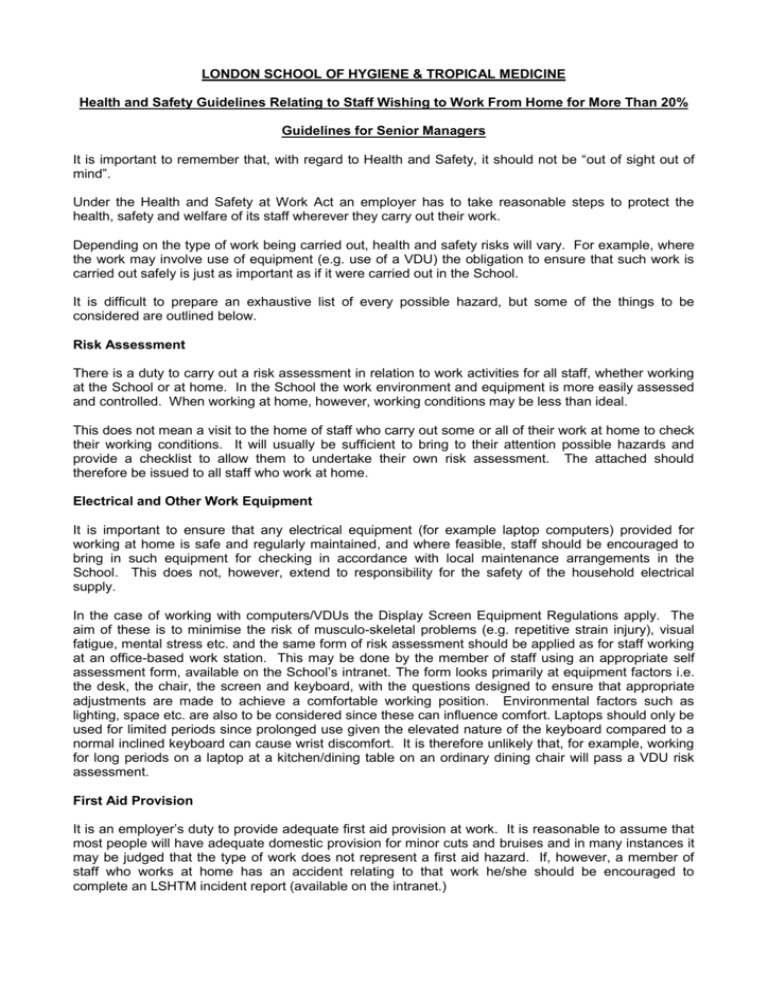
LONDON SCHOOL OF HYGIENE & TROPICAL MEDICINE Health and Safety Guidelines Relating to Staff Wishing to Work From Home for More Than 20% Guidelines for Senior Managers It is important to remember that, with regard to Health and Safety, it should not be “out of sight out of mind”. Under the Health and Safety at Work Act an employer has to take reasonable steps to protect the health, safety and welfare of its staff wherever they carry out their work. Depending on the type of work being carried out, health and safety risks will vary. For example, where the work may involve use of equipment (e.g. use of a VDU) the obligation to ensure that such work is carried out safely is just as important as if it were carried out in the School. It is difficult to prepare an exhaustive list of every possible hazard, but some of the things to be considered are outlined below. Risk Assessment There is a duty to carry out a risk assessment in relation to work activities for all staff, whether working at the School or at home. In the School the work environment and equipment is more easily assessed and controlled. When working at home, however, working conditions may be less than ideal. This does not mean a visit to the home of staff who carry out some or all of their work at home to check their working conditions. It will usually be sufficient to bring to their attention possible hazards and provide a checklist to allow them to undertake their own risk assessment. The attached should therefore be issued to all staff who work at home. Electrical and Other Work Equipment It is important to ensure that any electrical equipment (for example laptop computers) provided for working at home is safe and regularly maintained, and where feasible, staff should be encouraged to bring in such equipment for checking in accordance with local maintenance arrangements in the School. This does not, however, extend to responsibility for the safety of the household electrical supply. In the case of working with computers/VDUs the Display Screen Equipment Regulations apply. The aim of these is to minimise the risk of musculo-skeletal problems (e.g. repetitive strain injury), visual fatigue, mental stress etc. and the same form of risk assessment should be applied as for staff working at an office-based work station. This may be done by the member of staff using an appropriate self assessment form, available on the School’s intranet. The form looks primarily at equipment factors i.e. the desk, the chair, the screen and keyboard, with the questions designed to ensure that appropriate adjustments are made to achieve a comfortable working position. Environmental factors such as lighting, space etc. are also to be considered since these can influence comfort. Laptops should only be used for limited periods since prolonged use given the elevated nature of the keyboard compared to a normal inclined keyboard can cause wrist discomfort. It is therefore unlikely that, for example, working for long periods on a laptop at a kitchen/dining table on an ordinary dining chair will pass a VDU risk assessment. First Aid Provision It is an employer’s duty to provide adequate first aid provision at work. It is reasonable to assume that most people will have adequate domestic provision for minor cuts and bruises and in many instances it may be judged that the type of work does not represent a first aid hazard. If, however, a member of staff who works at home has an accident relating to that work he/she should be encouraged to complete an LSHTM incident report (available on the intranet.) LONDON SCHOOL OF HYGIENE & TROPICAL MEDICINE Health and Safety Guidelines Relating to Staff Wishing to Work From Home for More Than 20% Guidelines for Staff General Matters Most of the work undertaken by hourly paid School staff is generally administration, office/paper based work or work on a computer. In general, this is not work involving high risk, but there are two key areas to be aware of: Computer safety/security it is important to ensure that work moved on disk between home and the School does not transfer viruses to LSHTM machines you should ensure that your work is adequately backed up in case of e.g. disc corruption or damage in transfer you must ensure appropriate safeguards in relation to confidentiality of any material you are working on Health and Safety While LSHTM has a duty to take reasonable care of staff’s health and safety, Staff are expected to take primary responsibility for ensuring safe working conditions in their home. The following guidelines are aimed at raising your awareness of potential risks to health and safety which may result from working at home and indicating possible action you can take to provide safe working conditions. General Risk Assessment Principles In most cases, offices and other places of work are configured to ensure that the work carried out there is done safely. This is not necessarily the case when working at home. It should also be borne in mind that, although you may be aware of certain hazards associated with the work you are doing, your family or others in the home with you may not be. To take a simple example, if you are working with a lap top computer plugged in to the mains, the mains lead may be trailing across a part of the floor where other people may need to walk. This could result in them tripping over the mains lead, hurting themselves and damaging the computer. Whatever work you are doing, you should at least make a mental note of any possible risks to the health and safety of yourself and others who are present whilst you are working. If the risk is significant you should take appropriate steps to minimise the problems, where approriate seeking advice, assistance or resources from the LSHTM Safety Office. A basic Risk Assessment form is attached at the end of this document. This should be completed by the member of staff and submitted to their manager prior to commencement of the work. Hazardous Substances Staff are prohibited from taking hazardous substances (solvents, chemicals, biological agents, tissue etc. samples, radioactive material etc.) from the workplace to home. Electrical Equipment You are responsible for the safety of the wiring/electricity circuit in your home, but the School remains responsible for regular maintenance of any electrical equipment that it provides to allow you to carry out work at home. This means that if you are provided with a computer, for example, you should make sure that it is taken in to work periodically and checked to make sure it is safe. You should also ensure that you do not do anything that affects the health and safety of others in the home e.g. avoiding trailing leads. Some simple visual checks you can make on electrical equipment include: Check that plugs are not damaged Check that the outer covering of cable/wire leading to plugs is firmly gripped where it enters the plug or the equipment Check leads/wires/cables for damage to the outer covering Check that the outer cover of the equipment is not damaged – look out for loose parts or screws Check for burn marks or staining which may suggest overheating Display Screen Equipment If you do work at home on a VDU/Computer, the Display Screen Equipment Regulations apply and you should undertake an assessment of you workstation to make sure it does not constitute a health and safety hazard. (A self-assessment form is available on the LSHTM intranet. Attached to this document are some simple guidelines taken from the Health and Safety Executive's leaflet "Working with VDUs".) The aim of these regulations is to minimise the risk of musculo skeletal damage (e.g. repetitive strain injury often affecting wrists and forearms or back strain from inappropriate seating) and visual fatigue due to inappropriate lighting etc. The guidelines concentrate primarily on equipment factors i.e. the desk, the chair, the screen and keyboard with the questions designed to ensure that appropriate adjustments are made to achieve a comfortable working position. Environmental factors such as lighting, space etc. are also to be considered since these can influence comfort. Laptops should only be used for limited periods – say about an hour – since prolonged use given the elevated nature of the keyboard compared to a normal inclined keyboard can cause wrist discomfort. It is therefore unlikely that, for example, working for long periods on a laptop at a kitchen/dining table on an ordinary dining chair will pass a VDU risk assessment. Even with a conventional computer at a well configured work station it is important to take a break and vary your activity for a few minutes every hour to avoid the onset of physical, mental or visual fatigue. First Aid and Accident Reporting You will, no doubt, have the usual battery of minor medical supplies to deal with aches and pains, cuts and bruises and there will not be a need for the School to supply a First Aid kit for the type of work you do at home. If you do have a work related accident while working at home you should keep a brief record of what happened and any detrimental effects and submit an LSHTM Incident Form (available on the intranet). Health and Safety Executive Guidelines on Working with VDUs What can I do to help myself? Lots! You should make full use of the adjustment facilities for your VDU and work environment to get the best from them and avoid potential health problems. Here are some specific tips. Adjust your chair and VDU to find the most comfortable position for your work. As a broad guide, your arms should be approximately horizontal and your eyes at the same height as the top of the VDU casing. Make sure there is enough space underneath your desk to move your legs freely. Move any obstacles such as boxes or equipment. Avoid excess pressure on the backs of your legs and knees. A footrest, particularly for smaller users, may be helpful. Don't sit in the same position for long periods. Make sure you change your posture as often as practicable. Some movement is desirable, but avoid repeat stretching movements. Adjust your keyboard and screen to get a good keying and viewing position. A space in front of the keyboard is sometimes helpful for resting the hands and wrists while not keying. Don't bend your hands up at the wrist when keying. Try to keep a soft touch on the keys and don't overstretch your fingers. Good keyboard technique is important. Try different layouts of keyboard, screen and document holder to find the best arrangement for you. Make sure you have enough work space to take whatever documents you need. A document holder may help you to avoid awkward neck movements. Arrange your desk and screen so that bright lights are not reflected in the screen. You shouldn't be directly facing windows or bright lights. Adjust curtains or blinds to prevent unwanted light. Make sure the characters on your screen are sharply focussed and can be read easily. They shouldn't flicker or move. Make sure there are no layers of dirt, grime or finger marks on the screen. Use the brightness control on the screen to suit the lighting conditions in the room. LONDON SCHOOL OF HYGIENE & TROPICAL MEDICINE Health and Safety Guidelines Relating to Staff Wishing to Work From Home for More Than 20% Initial Risk Assessment This form should be used to undertake an initial assessment of the suitability of that part of an employees home which has been identified as the intended location for homeworking. Name of intended homeworker Home address Area of home intended to be used as workplace Managers name and telephone number Department / Course Summarise the main duties to be carried out and the equipment to be used. Name of assessor Date of assessment Part 1. 1. Is the size of the room adequate for the intended purpose and is there sufficient room to move around safely? 2. Is there a source of natural light? 3. Can the light be sufficiently controlled by blinds or curtains? 4. Is the artificial lighting sufficient for the intended tasks? 5. Is adequate ventilation available? 6. Does the heating system provide a comfortable temperature which is appropriate for the tasks? 7. Is there sufficient storage space for the intended range of tasks? 8. Are proposed work surfaces large enough for the intended tasks? 9. Has any computer or laptop been set up in accordance with the HSE & LSHTM guidance? 10. Is a suitably adjustable chair available? 11. Are there sufficient fixed electrical sockets to cope with essential electrical equipment? 12. Are electrical and telephone sockets appropriately located to avoid the need for trailing cables across the room(s)? 13. Is the work area suitable for manual handling activities? 14. If a smoke alarm is fitted, is it tested regularly? Y/N/n/a Comment Part 2 - Summary of Initial Homeworking Risk Assessment Following the Initial Homeworking Risk Assessment on page 1, the area proposed as a workplace is considered to be suitable subject to the following recommendations being implemented: Deficiency Assessors Recommendation (including timescale) e.g. proposed work surface too small e.g. Purchase desk Assessors signature Agreed by homeworker (Signature) Agreed by manager (Signature) Date Once the assessor has listed any deficiencies and recommendations, and signed the form, it should be returned to the manager so that both parties can agree the actions to be taken to ensure the intended workspace is safe and suitable.
